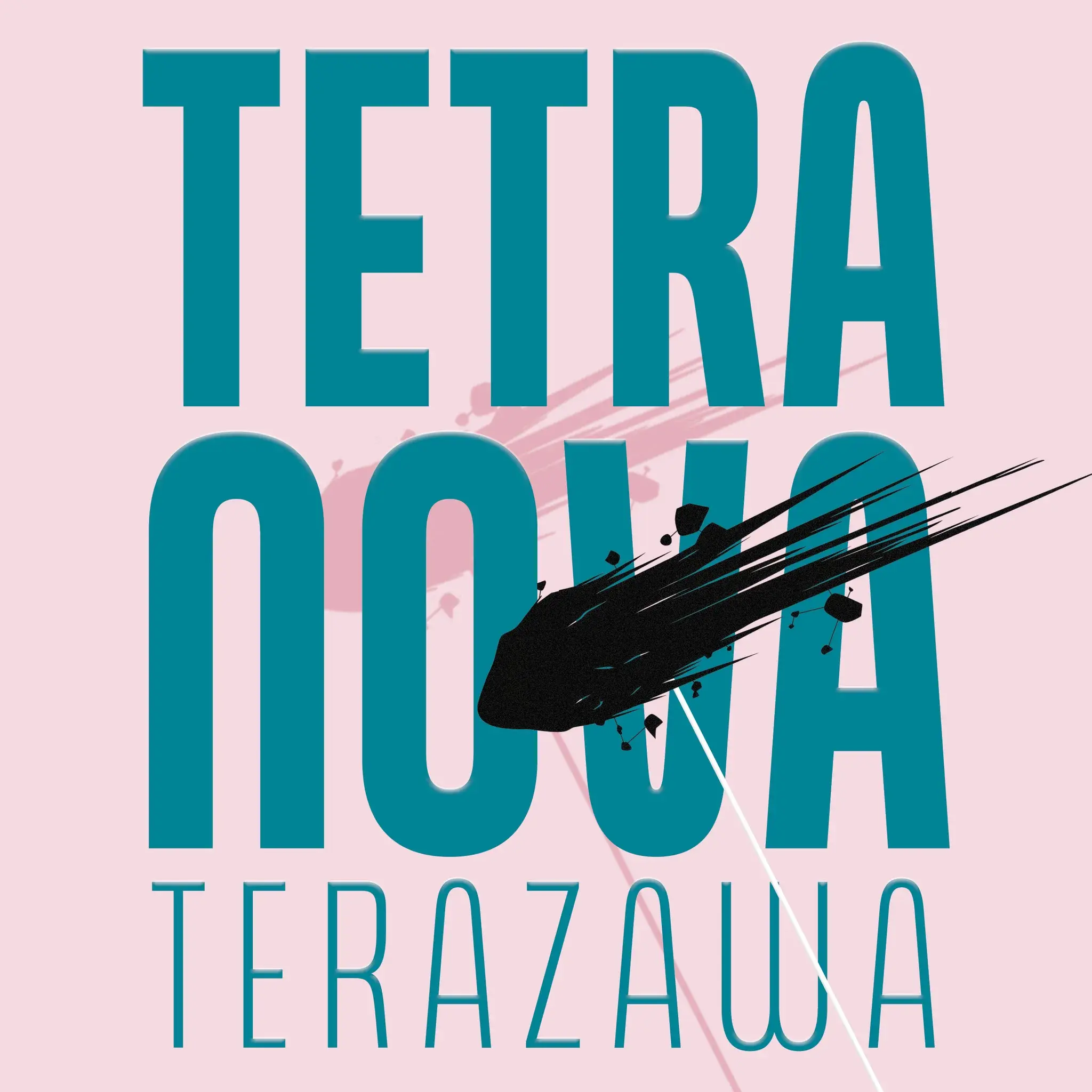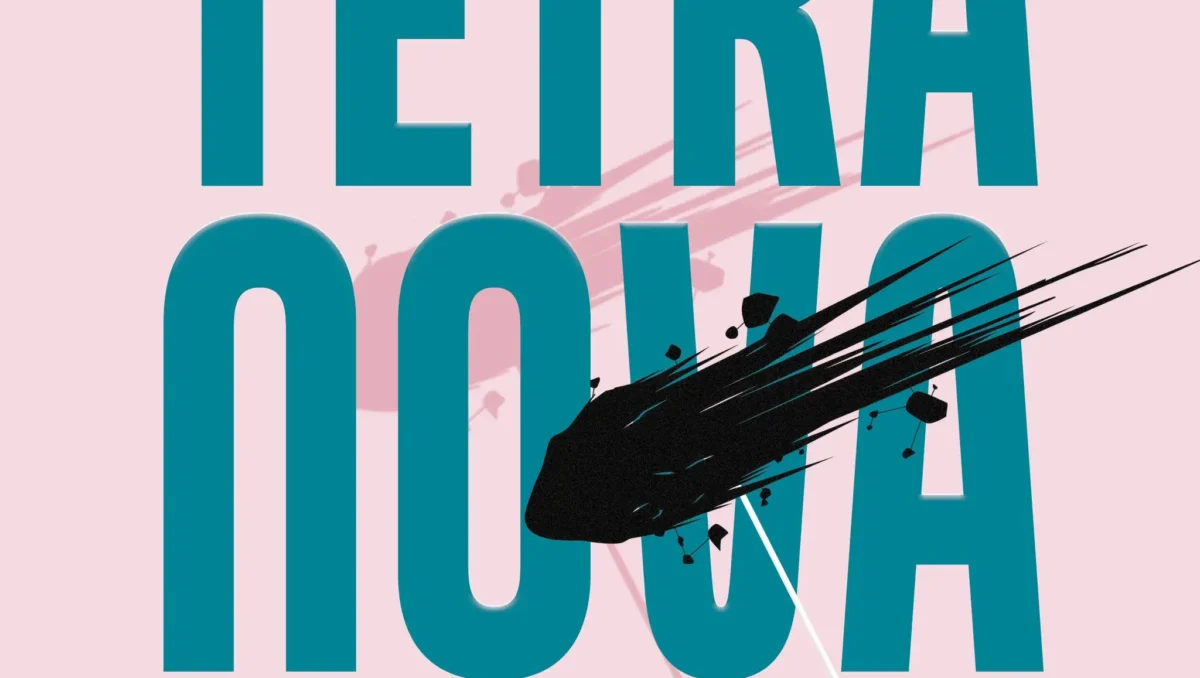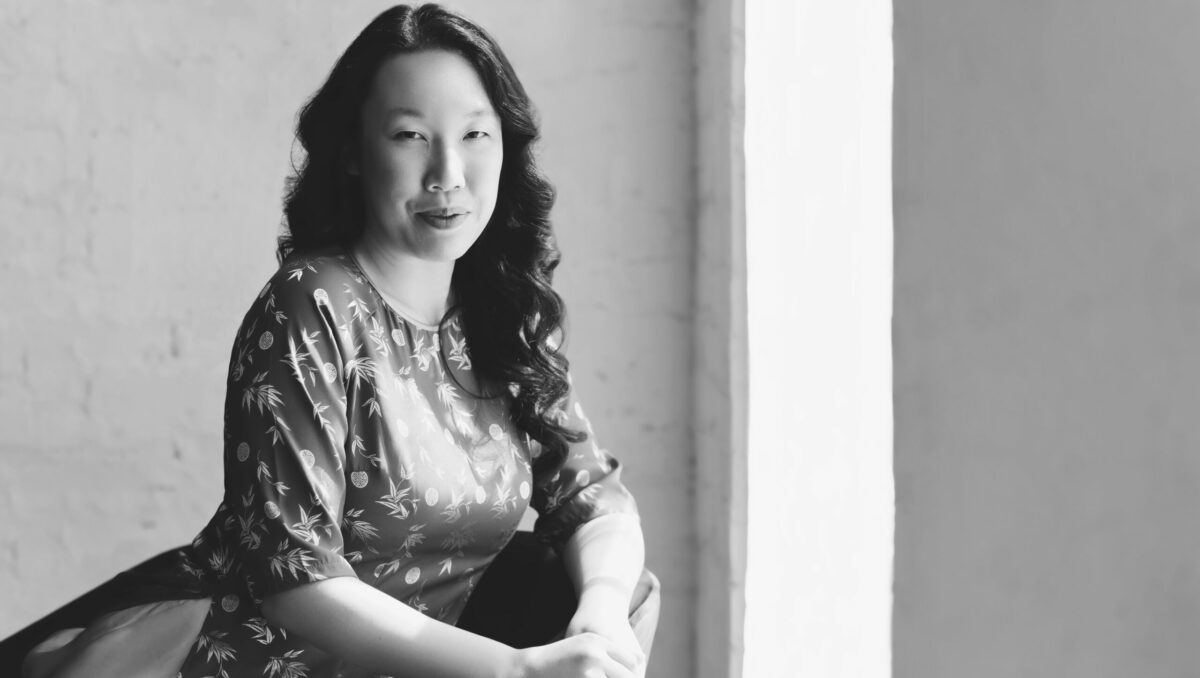MAY INTERVIEW WITH SOPHIA TERAZAWA

When readers first meet the narrator of Sophia Terazawa’s novel, Tetra Nova, published by Deep Vellum Publishing in March, they have just been trampled by an elephant, returning to consciousness inside what seems to be the body of a panda. Soon after, the narrator tumbles again, this time awakening as Emi, a young girl with a backpack full of crayons that she must use to draw an exit from the chamber she has found herself in. Emi, as we soon learn, is not only Emi. She is also Chrysanthemum, her Vietnamese grandmother, and Lua Mater, a little-known Roman war goddess-turned-assassin-turned-performance artist—and she is here to guide you on Terazawa’s stunningly polyvocal, spectacularly non-linear journey through time, space, memory, and identity. (Non-linear, as in: the novel’s Table of Contents can be found nearly a third of the way through the text, on page 95.)
Expanding the bounds of what a novel can do, Tetra Nova reads like a dream journal written by a poet who is also a performance artist moonlighting as a translator excavating generational trauma. Plus, there’s a panda named Panda.
Sophia Terazawa is interviewed by E Ce Miller.
FWR: The form and structure that Tetra Nova takes are mind-bending. The agility with which you move readers through literal millennia of space and time, sometimes in a single paragraph, cannot be overstated. In your writing process, how do form/structure and content develop—do you find that your material naturally lends itself to a particular shape, or do you set out to navigate your characters through a non-linear, multi-form narrative from the start?
ST: Oh, thank you for opening with such a generous question! My mind bends continuously. It’s unnatural and natural both, this material that becomes a long hall of mirrors around all of my books. For Tetra Nova, the process arrived as one might now attempt to describe the occasion of a fractal: fern, snowflake, Golden Ratio… I don’t know where to land next with its momentum, but the “multi-form narrative,” as you’ve aptly picked up, is a great place to start. And maybe opera, too… In the shower lately, I’ve been practicing a karaoke rendition of “O mio babbino caro” with full range and emotion!
Okay, did I set about shepherding the characters through their marked spots of entry and exit? With this question, I think of Viewpoints by Anne Bogart and Tina Landau, on “soft focus” required of performers to navigate the span of a stage or “grid” with imaginary lines and topographies. How it felt for me: voices moving along this grid at varying rhythms and slants, a sequence of vertical and horizontal trajectories, a philosophy of lunges along the metaphysical plane, [See: Illustration by Robert Faires for The Austin Chronicle], and, of course, mosaic time. I really did have a film camera in my eye!
FWR: I’m curious about whether/how you relate to the (typically Western, North American) resistance to non-linear plots. It’s a curious resistance, at least in my mind, because it seems non-linear is precisely how most minds work. So much of our lives are spent in memory, anticipation, imagination, distraction, intrusive thoughts, etc., most of us are traversing massive expanses of time and space all day long, and yet there is somehow a rejection of that when it comes to storytelling. What did this nonlinearity allow you to explore as a writer that a linear plot might not have?
ST: Memory makes more sense for me in the dream world, especially without language. Here, cities often occupy my subconscious—nameless cities, cities at night… If the poetic impulse, more specifically an aubade, is awakening with relative shock or ecstasy to some wild, unknowable Truth, it’s our morning bird song. It’s a lantern for dawn. It’s the act of recalling: “I remember you. I remember how it felt to be loved by you, just yesterday.” And this becomes a triumphant return after the long exile of desire. Yes, memory as anticipation…
With this logic, on the other hand, I think about prose in terms of a nocturne, which in turn leads to the promise of silence: “I leave the soprano aria of you behind. I accept that you will never return. I close my eyes. No, goodbye. Let me sleep.”
Ultimately, nonlinearity arrives at such promises of memory’s obliteration. Thinking too much about Tetra Nova in terms of day or night, however, makes me want to murmur about Eden: “Please don’t wake me in this burning garden.”
Or maybe to Eros: “Where have you been? I’ve been waiting for your touch my whole life.”
Lulled to further abstraction… Perhaps the intersecting plots of my novel don’t want to say anything in the end. Only suspension… Finally, I think of John Cage who referred to Duchamp’s assertion of music as “space art” rather than “time art,” perhaps a fractional equation of space divisible by time, or perhaps laughter that doesn’t require meaning. Laughing is just laughing! I’m happy for our gift of forgetfulness.
FWR: Naming is crucial to this book. The characters frequently announce themselves by name. The refrain, “My name is Lua,” is repeated many times. At one point, Chrysanthemum, upon arriving as a refugee in Michigan, says, “Yes, my name is whatever you want.” You also write: “As I write through the multiplicity of what is possible or not, my name becomes whoever is reading this, yours.” I’m interested in any thoughts you might have on the significance of naming: what it is for a character to declare their name, what it is for them to give that naming over to something outside of themselves, etc.
ST: Lacan! The mirror stage! [Laughs.] The unified self and “Coronus, the Terminator” by Flying Lotus…
The scene in Bergman’s Persona, where the doctor observes about the actress, Elisabet: “The impossible dream… not of seeming, but of being…”
The unnamed dead of my mother’s country, which no longer exists in the Real of her imaginary…
The refrain of Mahmoud Darwish’s eternal banishment: “Write down: I am an Arab…”
The lines of lament merging between Vietnam and Palestine…
To declare a name, then, as June Jordan declared her stakes through poetry, mirrors the significance of becoming human and not simply seeming human amidst the smoke and mirrors.
My mind is ignorant in many ways, but around these meeting points of justice, I’m firmly planted alongside a collective life force within multitudes of mortal dignity. And what I fail to articulate clearly with this reply can be summarized, perhaps at the very least, with an assertion that Tetra Nova is my Name. And it’s your Name, too, if you allow it. Strange, the declaration of these names across time loops back to my mother’s name and your mother’s name. Hence, the force launches time across immeasurable distances. Hence, the astral plane of travel! Wow! Let’s go!
FWR: Much of the polyvocality of Tetra Nova is contained within a single character who is Lua, Chrysanthemum, Emi, and occasionally others. At one point in the novel, this character says, “I started to have a nagging feeling that the voices between my grandmother, Chrysanthemum, and my mother, Emi, were merging with mine.” I’ve heard that every mother/daughter story is a circle. Thoughts?
ST: Yes, circles are bisected by lines as well. A plot point compels the sweep of a body in angles of Vitruvius, and architectures of thought collide with architectures of narration. [See: Illustration by Giacomo Andrea da Ferrara, prefiguring Leonardo da Vinci’s Vitruvian Man. Source: Ten Books on Architecture, Smithsonian.] Okay, let me try to reinterpret this in another way.
The square is set within its circle. Within the shapes are the rules of stage design. Within this design exists an elemental inscription of forces—wind, water, fire, earth—guiding the four corners of our planet back toward the center. The swordsmen of my father’s side, in The Book of Five Rings, might argue for our fifth element: Void, or the ether.
But I’m a simple thing with simple aspirations. Instead, I prefer melodramatic love scenes like the final declarative between Leeloo and Korben Dallas in the temple chamber of their heart, Mother and Father anchoring our profane and four-cornered worlds.
Watching this aforementioned scene had pushed me enough to orbit around the topic, and with a story, bickering between Aristotle’s concept of “potential infinite” and paradoxes of “actual infinite” compelling all points to wiggle. Love! Love! We want to shout.
FWR: Expanding on that question: At one point, readers are given the case notes from a technician at an institution where Emi is a patient. I’m curious how you think about this pathologizing of the polyvocal?
ST: Alright, so, in one of the hospitals of my past, I remember singing ALL of the time. It was insufferable; I was sorry for the revolving cast of staff and roommates. It couldn’t be stopped. And I remember eating a lot of cheese sticks during snack breaks. And I remember that somewhere amidst these iterations of asylum, Panda had been taken away at some point, as some sort of punishment. This made me Mad!
Therefore, what does the institutionalized memory say about pathology? I don’t think of “right” or “wrong” at this juncture because my commitment to the performance art kept us busy over those four extended residencies. We had roles to play and stage notes to take. It was a very serious time.
FWR: You write of the Vietnamese language: “…there is a word for unrequited love as a consequence of war through foreign dominance…” which is a line that just knocked me sideways. You also note that Vietnamese only has a present tense. In one of Tetra Nova’s “Citations,” you write of a photographer considering the D.C. Vietnam War memorial, quoting, “remembering does not come easily to Americans.” How do you relate memory and language? Do you think there is a quality to specific languages that makes their speakers more inclined to remember? Do particular languages lend themselves more easily to forgetting?
ST: I forget the best in English. My best self is in dancing. I’m inclined to feel that speakers know the gesture of a word before its utterance. As we move sideways, I invite us to return to the song, “In This Shirt” by The Irrepressibles, which had been played on a loop for the entire duration of composing Tetra Nova. And to the language of Complete Want, yes, the tonal mode of speaking inclines me more toward memory. It’s much easier to carry a melody in Vietnamese than in English. In Japanese, a syncopated rhythm is likened to cicadas… The best dreams are the ones in which I wake up singing.
FWR: There is also a point in your writing where the game Tetris and the English language are described similarly. If English is Tetris, what is Vietnamese? What about Japanese?
ST: Without English, time loses its container for me. To that point, Tetris has a start and stop point, much like spoken time. But neither Vietnamese nor Japanese operates like a game in my body. Marigolds perhaps come closest.
FWR: One of the central consciousnesses in Tetra Nova is Lua, this relatively unknown Roman war goddess who collected weapons captured from enemy combatants. Do you see language as one of these “captured weapons”? Is that something you ever consider as you write?
ST: Hmm, how spicy! A fabulous question! It is said that a mountain burns with the “elixir of immortality” by order of the Emperor, who is heartsick for the Moon Princess. This tale can be retold in numerous ways, including a version from my father, who recounted Kaguya’s journey for me as a child. He had been trying to explain the occasion of witnessing my birth without calling me by another boy’s name. Did he wish for my mother to name me Frederick instead? Did he wish for a minor god? I don’t know. But he had a story about me being born with a little monkey’s tail. The little tail fell off shortly after my earthly entrance, he alleged. Additionally, it was rare to hear me cry as a baby. Things were always falling off of me, I guess.
Lua, then, is she an “alter” personality? Calling back to your gentle concern about the “pathologizing of the polyvocal,” I can see connective tissues forming around a multiplied consciousness, the expansive Borgesian Library of Babel, and the bright hexagonal figure slowly taking shape. But I’m only still with the number four!
Oh, it now occurs to me in further overlapping shapes… Let’s see… If the artist’s work originates from a three-cornered plane, as Natsume Soseki ventured to paint, the written story gains its language through an additional angle, therefore moving toward the square of prose. Thus, ascending or descending toward the six-cornered form inches closer to a circle! Alright, so this hexagon is a ritual form. The pyre! [Laughs.]
FWR: In a LitHub essay, you wrote that you are the child of a parent raised by someone who had been a prisoner of war. I am also, and stories were told frequently about that family history when I was growing up. Of course, what was told, what wasn’t told, what became told differently over time, and the purpose of the telling all evolved and took on new forms as I grew older. It’s a story that, on some level, I think will continually evolve as long as I continue to consider it. I mention this because there are moments in Tetra Nova when the torture of women during the Vietnam War is recreated as performance art. At many points in the novel, it seems like performance is a vehicle for re-storying, if you will, for moving a story in all directions in time. Your characters are simultaneously ancestors and descendants; their stories are told and reimagined. You are also a performer—how do you articulate the relationship between your writing and performance art? Do you think there can be a restorative quality to telling, retelling/performing, and re-performing?
ST: Please let me share the full-hour performance of Tetra Nova, featuring the Roanoke Ballet Theatre. I hope this explains everything.
FWR: The jacket copy for Tetra Nova describes Lua and Emi as “embodied memory traveling across the English language.” How do you understand this concept of embodied memory? It strikes me as an interesting framing of what it means to be a being existing in time—are we all, for better or worse, really embodied memories? What does it mean to live as an embodied memory?
ST: One flaw in my mechanical design, among many flaws, is that I suffer from terrible motion sickness. If it weren’t for this stomach, I would have pursued as a young adult in this incarnation, in addition to studying divine geometry, a career in space travel. Strap me in! Shoot me up! Enjoy this illustrious life.
Alas, here we are… Yes, as you say, for better or for worse, the memory in a bottle rocket travels along a parabolic arc around the planet’s gravitational pull. Do you remember the seven comets passing by that night? I can only remember four. [See: Illustration by an unknown hand. Source: Mawangdui tomb, Hunan Province Museum]
FWR: I would be remiss, I think, if I didn’t offer an opportunity to discuss Panda directly. I often experienced Panda as an opportunity to indulge in some levity, in some whimsy, within this very charged, cerebral hurricane of a novel. I also experienced Panda as a very grounding presence. Who is Panda? (I see Panda also manages your website.) How do you hope readers experience Panda?
ST: Yay! With his consent, here’s a photo of Panda during the early part of his political endeavors. Thank you so much for speaking with us! This was a lot of fun!

[Photo of Panda by Sophia Terazawa]
- Published in Featured Fiction, home, Interview
TWO POEMS by Sophia Terazawa
Residual
These syllables strike our lower
register [branching: fog]. Who whispers
like a friend, “Bêche-de-mer,”
I wring out towels and pillow cases.
Sunday afternoon. Check on
your sister, you sign. She won’t speak
anymore. Glass trees.
Soapstone box. You package her father’s
old shirt there in Queens
[arms crossed at the chest] posing
unpalatably. I imitate you
imitating him like a tourist on the tenth
night of spring in a country bent
to numb what could hurt but doesn’t.
San Simeon
Dionysus, get up. Your friend is here. Smoke
on the portico, leafless, head to toe in gold.
Angus cattle roam past tomorrow,
startle into place; this home, measured by this
low thrumming. Get up. Wash your face.
Honeycomb patterns a handkerchief
rave, though he’s not my guest.
I won’t let him in. Hurry, mind the blue
marble. Sweet smoked hickory is a sarcophagus
between rooms cracking. This year
love will find me ready for it
helping ma with taxes. 24 adorned faces
will make a sentence, the old kind.
Suppose I wait longer than I should. Eve,
Oshōgatsu: oh, interminable want.

